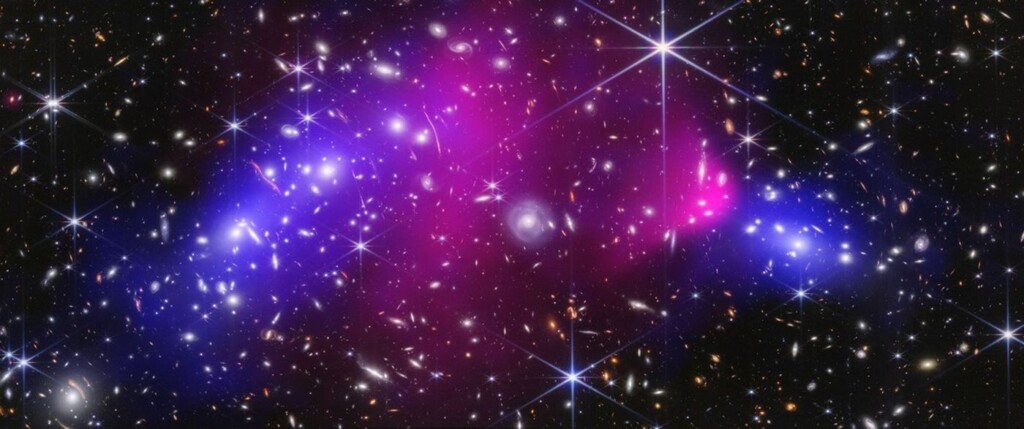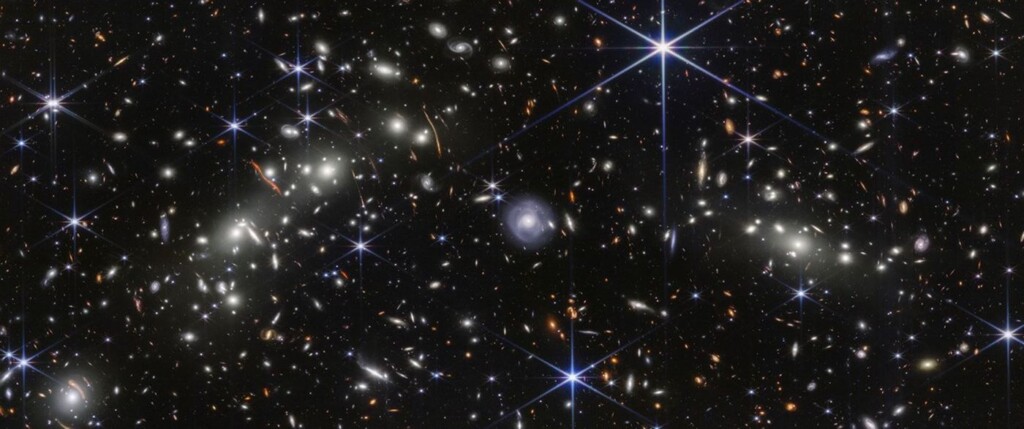 Glowing, hot X-rays captured by NASA’s Chandra X-ray Observatory appear in pink. The blue represents the dark matter, which was precisely mapped by researchers with Webb’s detailed imaging – credit, NASA, ESA, CSA, STScI, CXC; Science: James Jee (Yonsei University/UC Davis), Sangjun Cha (Yonsei University), Kyle Finner (IPAC at Caltech)
Glowing, hot X-rays captured by NASA’s Chandra X-ray Observatory appear in pink. The blue represents the dark matter, which was precisely mapped by researchers with Webb’s detailed imaging – credit, NASA, ESA, CSA, STScI, CXC; Science: James Jee (Yonsei University/UC Davis), Sangjun Cha (Yonsei University), Kyle Finner (IPAC at Caltech)Of course nothing and no one can actually see dark matter, but the accurate mapping of its warping influence on this new image from the James Webb Space Telescope is as good as it gets.
Containing two very large galaxy clusters, together known as the Bullet Cluster, the blue hues in the image represent where the light from galaxies in the background is passing through areas of dark matter which are altering it.
 The Bullet Cluster contains two massive galaxy clusters that sit on either side of the large, light blue spiral galaxy at the center – credit, NASA, ESA, CSA, STScI, CXC; Science: James Jee (Yonsei University/UC Davis), Sangjun Cha (Yonsei University), Kyle Finner (IPAC at Caltech)
The Bullet Cluster contains two massive galaxy clusters that sit on either side of the large, light blue spiral galaxy at the center – credit, NASA, ESA, CSA, STScI, CXC; Science: James Jee (Yonsei University/UC Davis), Sangjun Cha (Yonsei University), Kyle Finner (IPAC at Caltech)“Webb’s images dramatically improve what we can measure in this scene — including pinpointing the position of invisible particles known as dark matter,” said Kyle Finner, a co-author on a paper analyzing the data behind the images, and an assistant scientist at IPAC at Caltech in Pasadena.
All galaxies are made up of stars, gas, dust, and dark matter, which are bound together by gravity. These galaxy clusters act as gravitational lenses, magnifying and or distorting the light of background galaxies, and allowing scientists to infer the distribution of dark matter therein.
Currently an unsolved and hypothetical entity, dark matter is believed to constitute 85% of the matter in the universe. Because it doesn’t interreact with light or electromagnetism, dark matter exists to us only through its influence on visible matter. The influence takes the form of gravitational effects that cannot be explained by the theory of General Relativity.
After decades of studying the effects of dark matter, the general belief is that it builds structures as the universe expands, while at the same time another mysterious force, dark energy, is believed to be pushing those structures away from one another.
One of the best ways to study dark matter is to identify instances of gravitational lensing. James Jee, a co-author on the same paper, professor at Yonsei University, and research associate at UC Davis in California, explained to NASA that it’s like looking at stones below a pond of clear, still water.
“You cannot see the water unless there is wind, which causes ripples,” Jee explained. “Those ripples distort the shapes of the pebbles below, causing the water to act like a lens.”
ALSO CHECK OUT: Astronomers Detect Oldest Black Hole Ever Observed Dating ‘From the Dawn of the Universe’
In this example, the dark matter is the water and the background galaxies are the pebbles.
Jee, Finner, and their colleagues measured thousands of galaxies in Webb’s images to accurately “weigh” both the visible and invisible mass in these galaxy clusters. They also carefully mapped and measured the collective light emitted by stars that are no longer bound to individual galaxies—known as intracluster stars.
MORE OF JAMES WEBB’S RECENT WORK: James Webb Telescope Debuts New Trick: Blocking Out Stars and Photographing Their Planets
The revised map of the Bullet Cluster is shown in two layers. On top of an image from Webb’s NIRCam (Near-Infrared Camera) is data from NASA’s Chandra X-ray Observatory that shows hot gas in pink, including the bullet shape at right. Refined measurements of the dark matter, calculated by the team using Webb’s observations, are represented in blue.
“We confirmed that the intracluster light can be a reliable tracer of dark matter, even in a highly dynamic environment like the Bullet Cluster,” said the paper’s lead author, Sangjun Cha.
SHARE This Excellent Primer On Dark Matter And Its Effects From James Webb…
Source link

